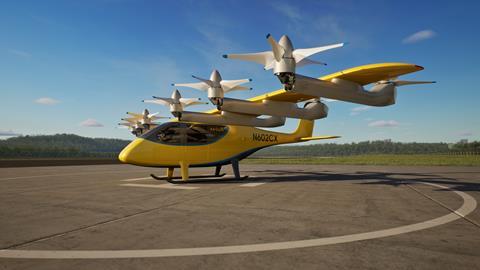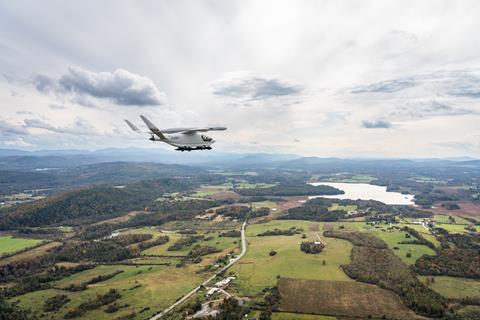Leading US air taxi companies pursuing certification of new and novel aircraft appear increasingly likely to launch passenger service not at home but in a Middle East region eager to embrace advanced air mobility.
Securing aircraft type certification with the Federal Aviation Administration before launching revenue flights in Dubai and Saudi Arabia is viewed by some industry observers as a highly probable path for both frontrunners in the field – Archer Aviation and Joby Aviation.
“They have been spending a lot of time in the region, generating deals and opportunities,” says Andres Sheppard, a senior equity analyst at Wall Street firm Cantor Fitzgerald. “The reality is that the jurisdiction and legislation there is perhaps more friendly than it is here, currently.”
Underscoring that reality, Archer on 24 April disclosed that it had secured an agreement with the Abu Dhabi Investment Office covering ”multi-hundred-million dollar investments to accelerate Archer’s planned commercial air taxi operations in the UAE”.
The San Jose-based company plans to launch passenger-carrying flights in the emirate as soon as next year, with its new deal representing another counter-move to Joby’s exclusive agreement to operate in Dubai. Chief executive Adam Goldstein calls the deal a “pivotal moment for Archer’s commercialisation efforts”.
Meanwhile, Joby’s chief executive JoeBen Bevirt was recently pictured presenting the company’s aircraft to Sheikh Mohamed bin Zayed Al Nahyan, president of the UAE.
US developers seeking to launch air taxi services with electric vertical take-off and landing (eVTOL) vehicles this decade are racing against time. They can afford to burn cash for only so long before they must generate revenue – and the Middle East appears to offer the fastest route to flying passengers, not to mention less-complex airspace for early operations.
“They are very much still going to pursue the US,” Sheppard says. “That is still by far the biggest market for them. But I think in the short term, if and when they get their FAA certification, launching in the [Middle East] region is very likely.”
Analyst Sergio Cecutta of SMG Consulting agrees with that assessment. Around this time last year, he says, much speculation surrounded which US city would be the first with air taxi service. “I don’t think anybody is talking about that anymore.”
Rather, Archer and Joby are jostling for position in the UAE’s desert metropolises. Archer recently announced plans to operate in Dubai despite Joby’s deal with Dubai’s Road and Transport Authority (RTA), granting it exclusive rights for air taxi operations within the emirate for a six-year period. Archer’s plans to fly between Dubai and Abu Dhabi appear unperturbed.
A lot is at stake, Sheppard says: “There are a lot of high-net worth individuals out there, and that’s putting it mildly.”

Joby will probably become the first eVTOL company to certificate its aircraft with the FAA, according to both Cecutta and Sheppard. Whether it is in a better long-term position than Archer is more subjective.
Santa Cruz-based Joby has a major lead on flight-testing its aircraft, with thousands of hours of flight time and a piloted demonstration in downtown Manhattan under its belt.
Archer, meanwhile, has been hovering Midnight for several months at its flight-test facility in Salinas but has yet to publicly disclose a successful transition to full-speed forward flight – a major milestone in any tiltrotor aircraft’s development programme. To date, Joby and Chinese start-up AutoFlight are the only companies with tiltrotor designs to achieve the feat with full-scale prototypes, Cecutta says.
Sheppard suggests that Archer may have the faster path to generating significant revenue because it intends to sell Midnight eVTOLs directly to operators, in addition to developing its own air taxi service, whereas Joby has not yet signalled interest in direct sales. And Archer may ultimately boast the industry’s most robust production capacity through its partnership with automotive giant Stellantis.
LEADING THE CHARGE
The FAA in March issued final airworthiness criteria for Joby’s eVTOL, marking a milestone in the company’s journey and paving the way for other US developers. That includes Vermont’s Beta Technologies, which is likely to be among the first companies to certificate a passenger-carrying electric aircraft in the USA.
Beta has taken criticism for developing a conventional take-off and landing (CTOL) variant of its all-electric Alia aircraft before advancing a similar eVTOL type for later certification. But Cecutta believes that Beta’s plan to pursue certification under the FAA’s Part 23 airworthiness standards for small aircraft is wise rather than roundabout.
”I give them plus points for the simple reason that there is extremely high commonality between the two platforms,” he says. “Their CTOL is a Part 23 airplane with a battery; nothing special. Once you’ve certified that under Part 23, you can take the majority of those documents and wrap them up under ‘powered lift’ and boom – you’ve got an eVTOL.”
Notably, Beta recently successfully transitioned a full-scale prototype of its eVTOL from hover to wing-borne forward flight – and back to hover – with a pilot onboard. The major technical achievement is distinct from a tiltrotor transition, as Beta’s craft is configured with four lift propellers and one aft-mounted pusher propeller for forward flight. The company is currently ranked first among US start-ups by SMG Consulting’s AAM Reality Index, most recently updated on 24 April.
Wisk Aero is taking a different approach altogether by building an autonomous and uncrewed eVTOL. For that reason, the company is generally seen as having longer-term ambitions. But it has also logged thousands of flight hours with several different generations of prototypes and is testing relatively mature technologies. Not to mention, it has backing from Boeing. Wisk is assembling a full-scale protoype at its facilities in Mountain View and may pursue a certification strategy starting in New Zealand. “In terms of technology, design and test flights,” Sheppard says, “they’re also right there.”

Florida’s Eve Air Mobility, backed by Embraer, also appears to be taking a more measured approach to market, building the industry’s largest tentative order book while spending heavily on developing its piloted, four-passenger eVTOL. Eve is currently assembling its first prototype and plans to launch a flight-test programme this year. It may possess an advantage because it is the only major air taxi company seeking certification first with Brazilian aviation regulators.
Rounding out the second wave of eVTOL developers in the USA, Hyundai-backed Supernal of Washington, DC, and Southern California’s Overair both appear to be on longer development timelines.
Sheppard describes Cantor Fitzgerald’s analysts as being among the most bullish on Wall Street regarding the eVTOL sector’s potential. He believes that, in the worst case, Archer and Joby achieve certification in 2026, and calls the air taxi business model “a no-brainer” – once it is up and running. Whether either Archer or Joby could afford major certification delays is another question.
“In Joby’s case, one of the reasons we like them is because they have the strongest balance sheet in the industry,” Sheppard says. “They have over $1 billion in liquidity. They have the highest cash burn in the industry but also the highest cash balance.”
“Obviously, that’s not infinite,” he continues. “If certification were to get pushed into 2027, which we don’t think will be the case, neither Joby nor Archer has enough liquidity on hand to get there, currently.” Though the sector is promising, practically all air taxi companies seeking FAA certification need more capital if their lofty ambitions are to be achieved.
When the first air taxi services launch in the USA, they will likely debut on downtown-to-airport routes in New York and Los Angeles. Sheppard identifies South Florida as another likely proving ground for eVTOLs. He envisions “limited” air taxi service in Los Angeles ahead of the 2028 Summer Olympics rather than the full-scale network with hundreds of aircraft that some have suggested could be up and running ahead of that event.
“I don’t think that 2028 is going to be where you can seamlessly move between an Uber, a bus, subway or taxi” into an eVTOL, Cecutta adds.
Regardless of how the US air taxi sector rolls out, even the bullish Sheppard admits that the industry remains speculative for now. “The reality is that no American eVTOL OEM has achieved certification, so it’s still a ‘show me’ story.”






























![[Photo] Korean Air K-UAM](https://d3lcr32v2pp4l1.cloudfront.net/Pictures/100x67/7/3/1/101731_photokoreanairkuam_478072.jpg)


